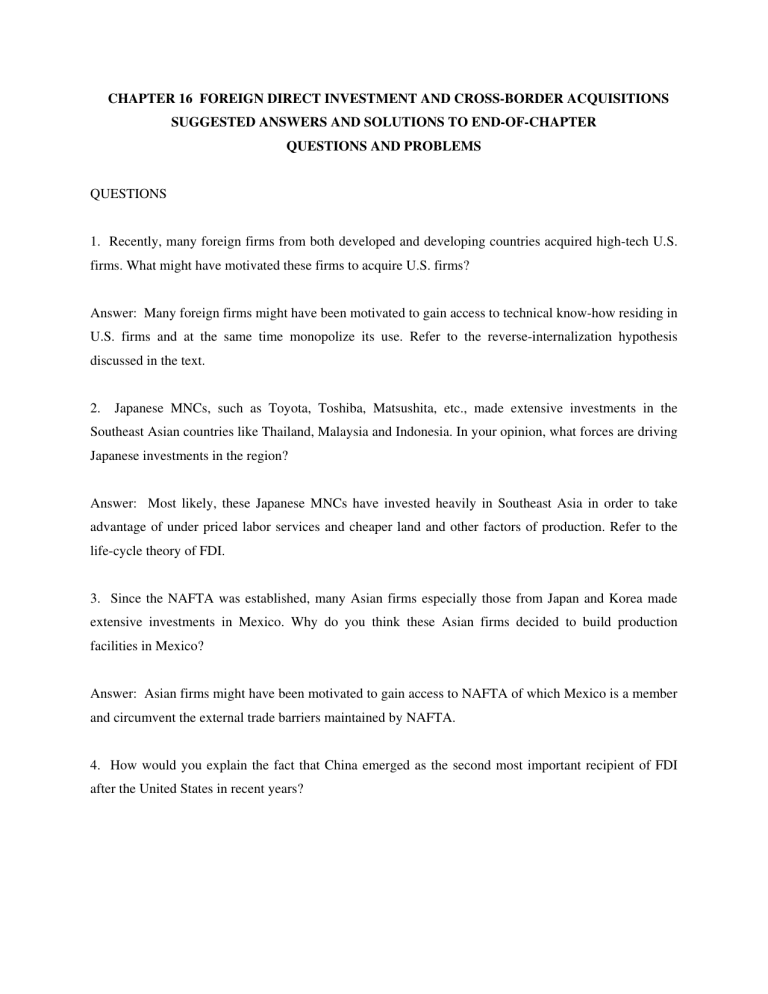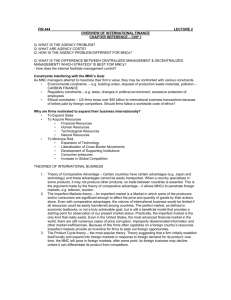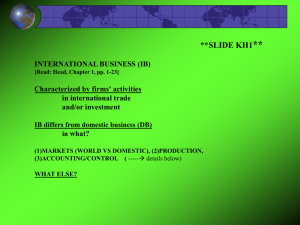
CHAPTER 16 FOREIGN DIRECT INVESTMENT AND CROSS-BORDER ACQUISITIONS SUGGESTED ANSWERS AND SOLUTIONS TO END-OF-CHAPTER QUESTIONS AND PROBLEMS QUESTIONS 1. Recently, many foreign firms from both developed and developing countries acquired high-tech U.S. firms. What might have motivated these firms to acquire U.S. firms? Answer: Many foreign firms might have been motivated to gain access to technical know-how residing in U.S. firms and at the same time monopolize its use. Refer to the reverse-internalization hypothesis discussed in the text. 2. Japanese MNCs, such as Toyota, Toshiba, Matsushita, etc., made extensive investments in the Southeast Asian countries like Thailand, Malaysia and Indonesia. In your opinion, what forces are driving Japanese investments in the region? Answer: Most likely, these Japanese MNCs have invested heavily in Southeast Asia in order to take advantage of under priced labor services and cheaper land and other factors of production. Refer to the life-cycle theory of FDI. 3. Since the NAFTA was established, many Asian firms especially those from Japan and Korea made extensive investments in Mexico. Why do you think these Asian firms decided to build production facilities in Mexico? Answer: Asian firms might have been motivated to gain access to NAFTA of which Mexico is a member and circumvent the external trade barriers maintained by NAFTA. 4. How would you explain the fact that China emerged as the second most important recipient of FDI after the United States in recent years? Answer: China attracted a great deal of FDI recently because foreign firms want to (I) take advantage of inexpensive labor and resources, and also (ii) gain access to the Chinese market that is often not accessible otherwise. 5. Explain the internalization theory of FDI. What are the strength and weakness of the theory? Answer: According to the internalization theory, firms that have intangible assets with a public good property tend to undertake FDI to take advantage of the assets on a large scale and, at the same time, prevent misappropriation of returns from the assets that may occur during arm’s length transactions in foreign countries. The theory can be effective in explaining greenfield investments, but not in explaining mergers and acquisitions. 6. Explain Vernon’s product life-cycle theory of FDI. What are the strength and weakness of the theory? Answer: According to the product life-cycle theory, firms undertake FDI at a particular stage in the life-cycle of the products that they initially introduced. When a new product is introduced, the firm chooses to keep production at home, close to customers. But when the product become mature and foreign demands develop, the firm may be induced to start production in foreign countries, especially in low-cost countries, to serve the local markets as well as to export the product back to the home country. As can be inferred from the boxed reading on Singer in the text, the product life-cycle theory can explain historical development of FDI quite well. In recent years, however, the international system of production has become too complicated to be explained neatly by the life-cycle theory. For example, new products are often introduced simultaneously in many countries and production facilities may be located in many countries at the same time. 7. Why do you think the host country tends to resist cross-border acquisitions, rather than greenfield investments? Answer: The host country tends to view green field investments as creating new production facilities and new job opportunities. In contrast, cross-border acquisitions can be viewed as foreign takeover of existing domestic firms, without creating new job opportunities. 8. How would you incorporate political risk into the capital budgeting process of foreign investment projects? Answer: One approach is to adjust the cost of capital upward to reflect political risk and discount the expected future cash flows at a higher rate. Alternatively, one can subtract insurance premium for political risk from the expected future cash flows and use the usual cost of capital which is applied to domestic capital budgeting. 9. Explain and compare forward vs. backward internalization. Answer: Forward internalization occurs when MNCs with intangible assets make FDI in order to utilize the assets on a larger scale and at the same time internalize any possible externalities generated by the assets. Backward internalization, on the other hand, occurs when MNCs acquire foreign firms in order to gain access to the intangible assets residing in the foreign firms and at the same time internalize any externalities generated by the assets. 10. What can be the reason for the negative synergistic gains for British acquisitions of U.S. firms? Answer: Negative synergies for British acquisitions of U.S. firms may reflect that British managers might have been motivated to invest in U.S. firms in order to pursue their own interests, such as building corporate empire, rather than shareholders’ interests. Negative synergies can be viewed as agency costs. 11. Define country risk. How is it different from political risk? Answer: Country risk is a broader measure of risk than political risk, as the former encompasses political risk, credit risk, and other economic performances. 12. What are the advantages and disadvantages of FDI as opposed to a licensing agreement with a foreign partner? Answer: The main advantage of FDI over licensing agreement with a foreign partner is that it provides protection against possible interlopers. The main disadvantage of FDI is that it is costly and time consuming to establish foreign presence in this manner and FDI is probably more vulnerable to political risk. 13. What operational and financial measures can a MNC take in order to minimize the political risk associated with a foreign investment project? Answer: First, MNCs should explicitly incorporate political risk in the capital budgeting process and adjust the project’s NPV accordingly. Second, MNCs can form joint-ventures with local partners or form a consortium with other MNCs to reduce risk. Third, MNCs can purchase insurance against political risk from OPIC, Lloyd’s, etc. 14. Study the experience of Enron in India, and discuss what we can learn from it for the management of political risk. Answer: This question can be used as a mini-case or mini-project. Students can utilize various business/financial publications, such as Wall Street Journal, Financial Times, and Business week, to study the issue. 15. Discuss the different ways political events in a host country may affect local operations of an MNC. Answer: The answer can be organized based on the three types of political risk: Namely, transfer risk, operational risk, and control risk. Transfer risk arises from the uncertainty about cross-border flows of capital, payments, know-how, etc. Operational risk arises from the uncertainty about the host country’s policies affecting the local operations of MNCs. Control risk arises from the uncertainty about the host country’s policy regarding ownership and control of local operations of MNCs. 16. What factors would you consider in evaluating the political risk associated with making FDI in a foreign country. Answer: Factors to be considered include: (1) the host country’s political and government system; (2) track record of political parties and their relative strength; (3) the degree of integration into the world system; (4) the host country’s ethnic and religious stability; (5) regional security; and (6) key economic indicators. 17. Daimler, a German carmaker, acquired Chrysler, the third largest U.S. automaker, for $40.5 billion in 1998. But after years of declining profit and labor problem, Daimler sold off Chrysler to the U.S. private equity firm Cerberus for $7.4 billion in 2007. Study the DaimlerChrysler saga and identify the main factors for the failure of this cross-border merger. Suggested answer: Daimler-Chrysler merger failed to produce synergy effect due to the failure to integrate the two companies with different corporate cultures, inability to cut down labor costs due to a strong labor union at Chrysler, and the competitive pressure from Japanese carmakers. Suggested Answers for Mini Case: Enron vs. Bombay Politicians [See Chapter 15 for the case text.] 1) Discuss the chief mistakes that Enron made in India. Suggested answer: Enron was insensitive to the negative political sentiment against foreign investment in India and ignored the possibility that BJP may win the election and repudiate the contract with Enron. In addition, the deal was closed in a hurry and secretly, giving the impression that it might have involved corruption. 2) Discuss what Enron might have done differently to avoid its predicament in India Suggested answer: Enron could have done a more accurate analysis of political risk and considered the possibility of election victory of the nationalist party. In addition, Enron could have purchased an insurance policy against this political risk from Overseas Private Investment Corporation or other insurers. Further, involving a local partner could have dampened the nationalistic sentiment in India.






